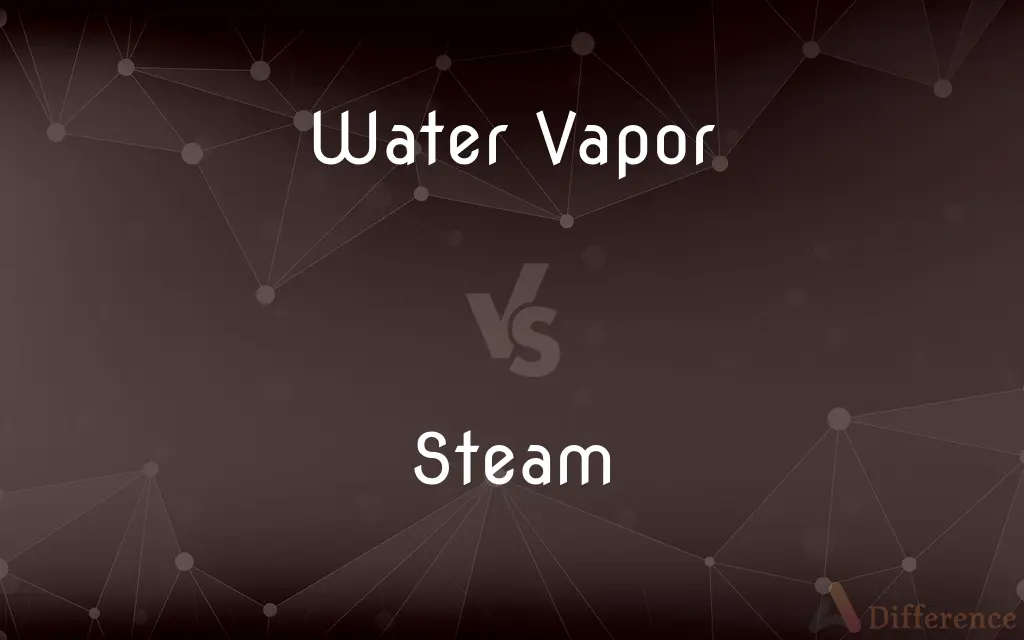Water Vapor vs. Steam — What's the Difference?
Edited by Tayyaba Rehman — By Fiza Rafique — Published on October 24, 2023
Water Vapor is gaseous phase of water in the air. Steam is visible mist formed when water vapor condenses.

Difference Between Water Vapor and Steam
Table of Contents
ADVERTISEMENT
Key Differences
Water Vapor and Steam both represent the gaseous form of water, but they differ in visibility and formation. Water Vapor is invisible and present in the atmosphere, whereas Steam is the visible mist or cloud formed when water vapor starts to condense.
The presence of Water Vapor in the atmosphere is essential for processes like evaporation and condensation, contributing to weather phenomena. Steam, on the other hand, is often seen rising from boiling water or from exhausts, where the hot water vapor encounters cooler air.
It's important to note that all Steam contains Water Vapor, but not all Water Vapor is visible as steam. The visibility factor differentiates the two; Water Vapor remains invisible while Steam offers a misty appearance.
When discussing humidity or the moisture content of the air, we're referring to Water Vapor. Conversely, when we talk about the fogging up of a bathroom mirror after a hot shower, we're discussing the presence of Steam.
In industrial contexts, Water Vapor might refer to the gaseous byproduct of various processes, while Steam typically refers to the controlled production of hot water vapor for tasks like power generation or heating.
ADVERTISEMENT
Comparison Chart
Definition
Gaseous form of water in the atmosphere.
Visible mist from condensed water vapor.
Visibility
Invisible.
Visible.
Relation
General term for water in gaseous state.
Specific form when water vapor condenses.
Contextual Use
Discussing humidity or atmospheric moisture.
Emanating from boiling water or hot surfaces.
Role in Weather
Contributes to cloud formation and precipitation.
Can be seen in phenomena like morning fog.
Compare with Definitions
Water Vapor
Atmospheric moisture in gas phase.
Water Vapor plays a crucial role in weather patterns.
Steam
Resultant mist when water boils.
The kettle whistled and let out a burst of Steam.
Water Vapor
Airborne water molecules in gaseous state.
Water Vapor rises from the ocean, contributing to cloud formation.
Steam
Hot water vapor produced especially by boiling liquid water.
Water Vapor
Gas phase of water, undetectable by the naked eye.
Despite being invisible, Water Vapor significantly impacts our climate.
Steam
Hot, pressurized water vapor used for heating, cooking, or to provide mechanical power.
Water Vapor
Invisible gaseous form of water.
The amount of Water Vapor in the air determines humidity levels.
Steam
Power generated by the expansion of boiling water as it turns to vapor
An engine at full steam.
Water Vapor
Evaporated water present in the atmosphere.
Hot climates often have high levels of Water Vapor in the air.
Steam
Steam heating.
Steam
Condensed water vapor in the form of a mist or cloud
The steam from the teakettle.
The steam of the oxen's breath in the cold air.
Steam
Power; energy
The fundraising effort ran out of steam.
Steam
To produce or emit steam
The kettle is steaming. Let's make tea.
Steam
To become or rise up as steam
The rain steamed off the hot pavement.
Steam
To become misted or covered with steam
The bathroom mirror steamed over.
Steam
To move by means of steam power.
Steam
(Informal) To become very angry; fume.
Steam
To expose to steam, as in cooking.
Steam
To cover or mist with steam
The windows are steamed up.
Steam
(Informal) To make angry
His laziness really steams me.
Steam
The vapor formed when water changes from the liquid phase to the gas phase.
Steam
The suspended condensate (cloud) formed by water vapour when it encounters colder air
Steam
, fog
Steam
Exhaled breath into cold air below the dew point of the exhalation
Steam
Pressurized water vapour used for heating, cooking, or to provide mechanical energy.
Steam
The act of cooking by steaming.
Give the carrots a ten-minute steam.
Steam
(figuratively) Internal energy for motive power.
After three weeks in bed he was finally able to sit up under his own steam.
Steam
(figuratively) Pent-up anger.
Dad had to go outside to blow off some steam.
Steam
A steam-powered vehicle.
Steam
Travel by means of a steam-powered vehicle.
Steam
(obsolete) Any exhalation.
Steam
(fencing) Fencing without the use of any electric equipment.
Steam
To cook with steam.
The best way to cook artichokes is to steam them.
Steam
(transitive) To expose to the action of steam; to apply steam to for softening, dressing, or preparing.
To steam wood or cloth
Steam
(intransitive) To produce or vent steam.
Steam
(intransitive) To rise in vapour; to issue, or pass off, as vapour.
Our breath steamed in the cold winter air.
Steam
To become angry; to fume; to be incensed.
Steam
To make angry.
It really steams me to see her treat him like that.
Steam
(intransitive) To be covered with condensed water vapor.
With all the heavy breathing going on the windows were quickly steamed in the car.
Steam
(intransitive) To travel by means of steam power.
We steamed around the Mediterranean.
The ship steamed out of the harbour.
Steam
To move with great or excessive purposefulness.
If he heard of anyone picking the fruit he would steam off and lecture them.
Steam
(obsolete) To exhale.
Steam
Old-fashioned; from before the digital age.
Steam
The elastic, aëriform fluid into which water is converted when heated to the boiling point; water in the state of vapor.
Steam
The mist formed by condensed vapor; visible vapor; - so called in popular usage.
Steam
Any exhalation.
Steam
To emit steam or vapor.
My brother's ghost hangs hovering there,O'er his warm blood, that steams into the air.
Let the crude humors danceIn heated brass, steaming with fire intense.
Steam
To rise in vapor; to issue, or pass off, as vapor.
The dissolved amber . . . steamed away into the air.
Steam
To move or travel by the agency of steam.
The vessel steamed out of port.
Steam
To generate steam; as, the boiler steams well.
Steam
To exhale.
Steam
To expose to the action of steam; to apply steam to for softening, dressing, or preparing; as, to steam wood; to steamcloth; to steam food, etc.
Steam
Water at boiling temperature diffused in the atmosphere
Steam
Travel by means of steam power;
The ship steamed off into the Pacific
Steam
Emit steam;
The rain forest was literally steaming
Steam
Rise as vapor
Steam
Get very angry;
Her indifference to his amorous advances really steamed the young man
Steam
Clean by means of steaming;
Steam-clean the upholstered sofa
Steam
Cook something by letting steam pass over it;
Just steam the vegetables
Steam
Visible mist from water vapor condensation.
Boiling water releases Steam into the air.
Steam
Gaseous water turning visible upon cooling.
The hot shower filled the bathroom with Steam.
Steam
Misty appearance when hot water vapor meets cool air.
The cold morning turned the Steam from the train's exhaust into thick plumes.
Steam
Condensed water vapor forming a visible cloud.
Steam rose from the streets after the rain.
Common Curiosities
What makes Steam visible then?
Steam is the result of Water Vapor condensing, forming a visible mist or cloud.
What's the primary source of Water Vapor in the atmosphere?
Evaporation from bodies of water, like oceans and lakes, is the primary source.
How is Steam typically produced?
Steam is commonly produced when water boils or when hot water vapor meets cooler air.
Can we say all Steam contains Water Vapor?
Yes, all Steam contains Water Vapor, but not all Water Vapor is visible as Steam.
Is Water Vapor always gaseous?
Yes, by definition, Water Vapor is the gaseous phase of water.
Is Steam only produced from water?
In common usage, yes, but technically, other liquids can also produce "steam" when vaporized.
Is Water Vapor lighter than air?
Yes, Water Vapor is less dense than dry air, making it rise.
Is Water Vapor visible to the naked eye?
No, Water Vapor is invisible; it's the gaseous form of water in the atmosphere.
Can Steam be dangerous?
Yes, especially if it's pressurized or superheated, as it can cause burns or explosions.
Is the steam used in steam engines the same as the steam we see from boiling water?
Essentially, yes, but in engines, it's controlled and pressurized for power generation.
What determines the humidity in the air?
The amount of Water Vapor present in the air determines its humidity.
Do saunas use Steam or Water Vapor to create heat?
Saunas typically use Steam, generated by pouring water on heated rocks.
Can we feel Water Vapor?
Not directly, but we can feel its effects, like when the air feels humid.
How do clouds relate to Water Vapor and Steam?
Clouds form when Water Vapor condenses, turning it into a visible form similar to Steam.
Does Water Vapor play a role in the greenhouse effect?
Yes, Water Vapor is a significant greenhouse gas that traps heat in the atmosphere.
Share Your Discovery

Previous Comparison
Condiments vs. Spices
Next Comparison
Case Study vs. PhenomenologyAuthor Spotlight
Written by
Fiza RafiqueFiza Rafique is a skilled content writer at AskDifference.com, where she meticulously refines and enhances written pieces. Drawing from her vast editorial expertise, Fiza ensures clarity, accuracy, and precision in every article. Passionate about language, she continually seeks to elevate the quality of content for readers worldwide.
Edited by
Tayyaba RehmanTayyaba Rehman is a distinguished writer, currently serving as a primary contributor to askdifference.com. As a researcher in semantics and etymology, Tayyaba's passion for the complexity of languages and their distinctions has found a perfect home on the platform. Tayyaba delves into the intricacies of language, distinguishing between commonly confused words and phrases, thereby providing clarity for readers worldwide.












































